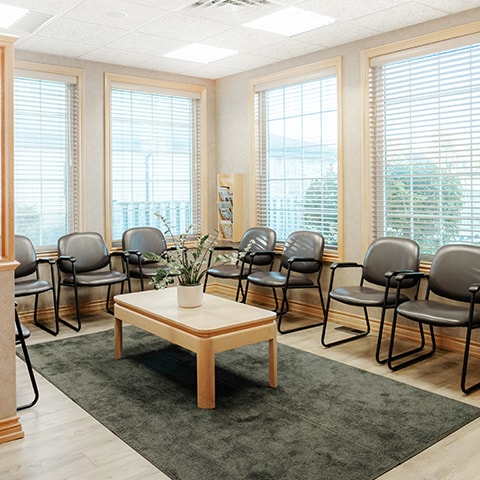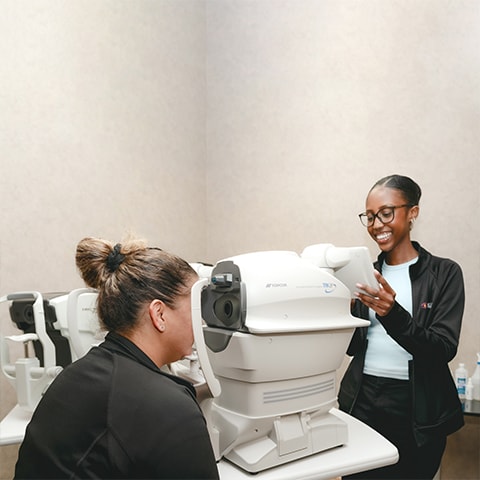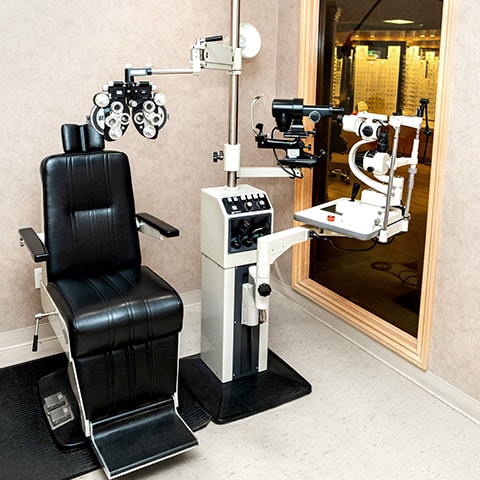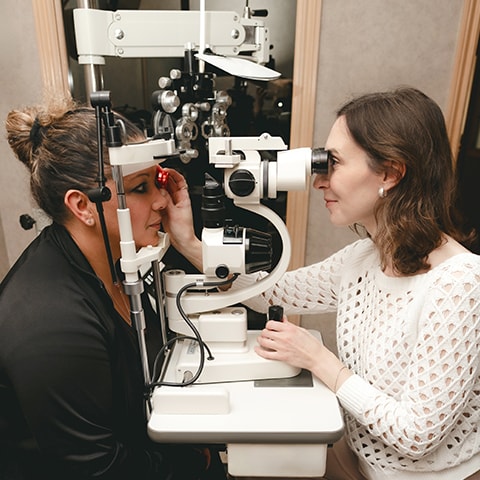Protecting Your Sight from Invisible Damage
Did you know that 90% of vision loss is treatable or preventable? Regularly scheduled, comprehensive eye exams are a key component of preventive health care, as optometrists can detect many eye diseases and conditions before you notice symptoms.
We invest in effective, thorough diagnostic technology that supports our optometrists in catching signs of eye diseases early. When we detect conditions early, we may be able to slow the progression or prevent vision loss that would occur without timely intervention.
Protect your sight for the future and book your eye exam today.
Request AppointmentWhy Early Diagnosis Matters?
Many chronic conditions, such as macular degeneration, diabetic eye disease, and glaucoma, can cause irreversible damage to your eyes before you experience changes to your vision. However, when these conditions are caught early, more intervention options are available to treat and manage them.
After diagnosis, we’ll work together to create a treatment plan that targets your specific diagnosis and works for your lifestyle.
Eye Diseases We Diagnose & Manage
We understand it can be stressful to live with a family history of eye disease or with chronic conditions that increase your risk, such as high myopia or diabetes. Our experienced optometrists are here to provide answers to all your questions.
Our approach to managing eye diseases begins with preventive health. We provide regular eye health screenings during routine eye exams to help us detect signs of eye disease before you notice any symptoms.
Learn more about the conditions that we can diagnose, monitor, and manage.
Age-related Macular Degeneration (AMD)
AMD causes the breakdown of the macula, which is the part of the eye responsible for your central vision. Damage to the macula from AMD can lead to central vision loss, making it difficult or impossible to drive, read, write, or even recognize faces.
During early stages, AMD is often symptom-free and only detected through an eye exam. As the disease progresses, signs of AMD include blurry central vision even with glasses, dark or missing spots in your vision, and straight lines that appear wavy. If you notice these symptoms, book an eye exam right away.
Cataracts
Cataracts have many causes, but the most common is age. Cataracts form when the clear lens inside your eye becomes clouded and affects vision.
Other causes of cataracts include UV damage, trauma, and other conditions such as diabetes. Wearing sunglasses with UV protection whenever you’re outdoors can slow the development of cataracts.
In early stages, cataracts are treated with updated glasses or contact lenses to keep your vision sharp. When the cataracts begin to impact your daily life and cannot be corrected with lenses, your optometrist will refer you to a surgeon to remove the cataracts.
Diabetic Eye Disease
People with diabetes are at an increased risk for conditions such as diabetic retinopathy and diabetic macular edema. Both of these conditions can lead to irreversible vision loss if left untreated.
Diabetic retinopathy occurs when prolonged levels of high blood sugar affect the blood vessels in the retina and cause bleeding, swelling, or abnormal blood vessel growth, which may impact vision. Diabetic macular edema occurs when the macula, the part of the eye responsible for central vision, swells and impacts vision.
Both conditions can be detected through a comprehensive diabetic eye exam. Annual eye exams are an important preventive measure for people living with diabetes.
Glaucoma
Glaucoma refers to a group of conditions affecting the optic nerve and is one of the leading causes of blindness in Canada, known as “the silent theft of sight”. Glaucoma has no noticeable symptoms during its early stages.
Symptoms of glaucoma in later stages include blurry vision, eye pain, light sensitivity, halos around lights, headaches, and vision loss, especially in side or peripheral vision.
We test for glaucoma by checking the pressure inside your eyes and inspecting the optic nerve for damage using diagnostic imaging tests such as OCT and fundus photography.
Dry Eye Disease
Dry eye disease, or ocular surface disease, is a group of conditions that impact the surface of your eye. Initially characterized by a scratchy, gritty feeling in the eyes, dry eye can cause damage to the outer surface of the eye, including the cornea, if left untreated.
Treatments for dry eye disease include medicated eye drops, warm compresses, and gentle cleansers that tackle the root cause of your symptoms and restore healthy tear production.
Flashes & Floaters
Flashes of light or spots floating in your vision can indicate changes to the vitreous gel inside the eye. While often harmless, flashes and floaters can sometimes signal a more serious condition, such as retinal detachment, which could lead to vision loss.
If you notice any changes to your vision, come in for an eye exam right away. We’ll check for any underlying causes and rule out any serious conditions before permanent damage occurs.
Our Technology to Diagnosis & Monitor Eye Conditions
At East London Optometry, we invest in innovative technology that helps us detect conditions earlier to improve treatment options and outcomes. Some of the technology we may use during your exam includes:
- Topcon Maestro OCT: Optical coherence tomography (OCT) scans are a noninvasive imaging technique that uses light waves to map cross-sections of your retina.
- Fundus Photography: Fundus photos are detailed images of the inside of your eye, showing your retina, macula, blood vessels, and optic nerve.
- Corneal Pachymetry: Measures the thickness of your cornea, used to screen for glaucoma and to determine eligibility before laser eye surgery.
- Humphrey Visual Field Machine: Measures the range of vision you have while your eyes are fixed on a single point. Used to screen for glaucoma, AMD, and more.
Stay Ahead of Eye Disease
Regular, comprehensive eye exams are the best defence against eye diseases like glaucoma, diabetic retinopathy, and AMD. Most adults should have an eye exam at least once every 2 years, but other factors, such as existing health conditions, may mean we recommend more frequent exams.
If you notice any sudden changes to your vision, like flashes, floaters, or tunnel vision, don’t hesitate to contact us. We’re here to help you see clearly and keep your eyes healthy for the long term.
Request AppointmentVisit Our Location
Find us just past the Hale Street and Hamilton Road intersection, heading east on Hamilton Road. Convenient parking is available in our lot.

Our Address
- 999 Hamilton Rd.
- London, ON N5W1A4
Contact Information
- Phone: 519-451-5111
- Fax: 519-451-6628
- Email: admin@eastlondonoptometry.com
Our Hours
- Monday: 8:30 AM – 5:00 PM
- Tuesday: 8:30 AM – 5:00 PM
- Wednesday: 8:30 AM – 8:00 PM
- Thursday: 8:30 AM – 8:00 PM
- Friday: 8:30 AM – 5:00 PM
- Saturday: 9:00 AM – 1:00 PM
- Sunday: Closed
-
Closed on Saturdays for long weekends and during July and August
Our Brands
































